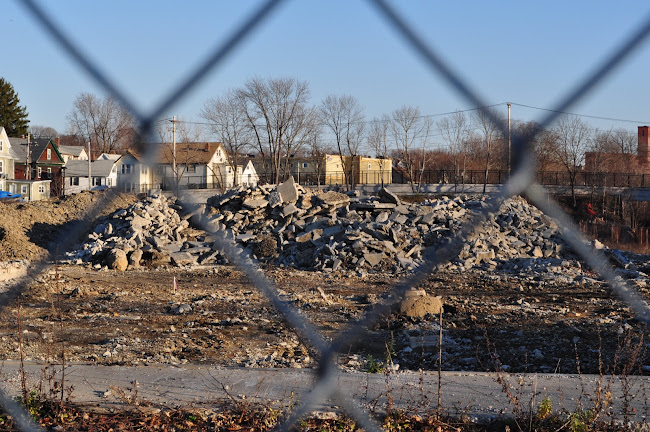Then: Data unknown, from MACRIS database
Now: Dec. 2, 2010
Continuing from the previous two entries, I've been sketching the industrial past of the Minuteman Bikeway and its extensions.
The ruin of a gigantic paper box factory used to stand on a tip of a delta island created by the arrays of railways and ex-railways. I said "used to" because this iconic ruin is already demolished. I wish I took some pictures a year ago or so, but what is gone is gone. At least I can show you what is left. Good news is that there are cool pictures documenting the factory inside and out, and can be seen via Flicker like here and there.
From Google Street View retrieved on Nov. 29
The factory building was known as the International Paper Company because of the fading sign on the building. According to the MCRIS database, it was constructed in 1928 as "Agar Manufacturing Corrugated Box Co.". History suggests the site had been a brickyard before the construction of the factory. Anyway, the building was a paper box factory.
What surprised me was its size:
The above is a screen shot of a cleared site. The length of the factory must have been over 600ft (180m). Compare with the surrounding houses! While separated by train tracks (or the remain of them), how close the factory and the surrounding houses were, too.
Not only the size and the proximity to the surrounding houses but also the height of the factory was astonishing; it was well over roomy 4 stories. When I first saw the abandoned factory, I thought it was an engine shed because the site was adjacent to a junction of the two railroad services; trains from Boston split off at the tip of the factory site to the Boston and Lowell Railroad (main line) or the Lexington and Arlington Railroad (the acquisition of the B&L ).
From Google Street View retrieved on Nov. 29
But for an engine shed, I guess the height of 4 stories is too much. Even for a paper box manufacturing, though. Were they manufacturing a cardboard house, or the capitalist's precursor of the Trabant?
But I remembered that the J.H. Emerson's main office (an Iron Lung manufacturing company) was originally owned by the Climax Paper Box Company. The loft was built in 1909 and J.H. Emerson Co. took over the place by 1937 (from Cambridge Historical Commission in PDF). I guess many paper box companies clustered along the Lexington and Arlington Railroad, but why? That's an interesting question that I don't know yet.
The last passenger service of the Lexington and Arlington was in 1977, and the final freight service was in 1981.The L&A side of the train tracks has been cleared, making a way for the future Muniteman Bikeway extension that connects Lexington and Boston. However, the path beyond Cedar St is still unpaved and an off-limit.
The future bike path goes beyond Cedar St, the factory site on the left
The future bike path towards Cedar St, the factory site on the right
The Boston and Lowell Railroad tracks are still in use
Where the junction used to be. Can you see the B&L Railroad tracks?
When the bikeway extension is completed in the future, the factory site will be converted to something else. A public park, another condo? I'll keep on checking what is going to happen to the site.
Locate Intl. Paper Co. @ Google Map
Click picture to enlarge
MACRIS Database: Agar Manufacturing Corrugated Box Company Building
borisjason's Flicker: http://www.flickr.com/photos/bjm/sets/72157604101488733/
dzm's Flicker: http://www.flickr.com/photos/dzm/sets/72157603764559143/
City of Somerville: MaxPak Planning














Hello Shuko-san,
ReplyDeleteI moved to Warwick st in September, so this is right in my backyard! Too bad I didn't live here when the building still stood. I'm a college student at UMass Boston, (studying Japanese interestingly enough,) and will be done with school in December. I love this area and have been developing a huge interest in urban exploration and old architecture lately. I'm glad I found your blog! I'm planning on doing a little exploring of my own sometime very soon. I find all of this really fascinating.
ありがとうございます
~Chris
Hi Chris-san,
ReplyDeleteYes, it was quite a sight the factory was. But I think workers cottages for the brickyard are still around the factory site...maybe it's even the house you are living.
If you like ruins and Japanese culture, have you read about the "Royal House Haikyo"?
Shuko